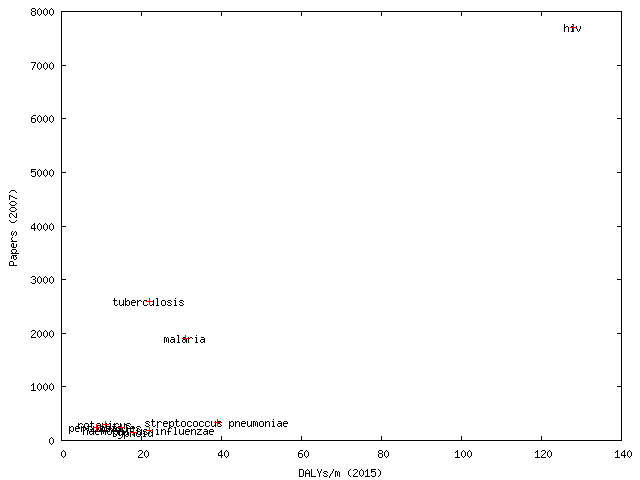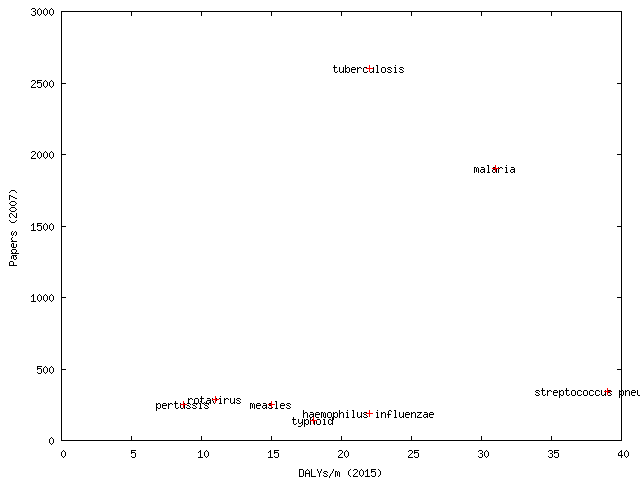Diseases
Why infectious diseases?
We are interested in obtaining as much bang for the buck as possible.
This tends to tilt things in the following directions:
- towards diseases that cause the most death and suffering
- since this is what we want to help alleviate
- the payoff of a given amount of R&D scales with the amount of suffering a disease causes
- the payoff of vaccination is scales with the amount of suffering a disease causes
- towards diseases of the developing world - since this is where most of us live
- towards infectious diseases
- since these are the major causes of morbidity and mortality in the developing world
- and infectious diseases get relatively less investment than the diseases of the developed world and so the potential for unexplored opportunities is higher
Which infectious diseases are heavily researched and which are under-researched?
Figuring out how much research money goes into researching different
diseases is a challenging problem. Lewison,
et al. use a novel solution to this problem. They find that
nearly all publicly funded research ends up getting published. They
also find that the amount of research funding for a typical paper is
in the range $50-250k, with a mean cost of $170k. To first order
then, it is possible to approximate funding by counting the number of
papers published in scientific journals.
WHO has published Global Burden
of Disease estimates, estimating the cost of various diseases in
Disability Adjusted Life Years, or DALYs. Combining the GBD data with
a quick PubMed count for the name of each disease appearing in a
paper's title gives the following (diseases with 5m or more
DALYs/year):

Zooming in:

Or the raw data:
| disease / keywords | papers (2004) | papers (2007) | DALYs (2002) | DALYs (2015) | papers per million DALYs | work required
|
| hiv OR AIDS | 6300 | 7700 | 84m | 128m | 60 | research/economics
|
| malaria OR plasmodium | 1600 | 1900 | 46m | 31m | 61 | research/economics
|
| tuberculosis | 2100 | 2600 | 35m | 22m | 120 | research/economics
|
| streptococcus pneumoniae | 330 | 340 | ~30m | ~39m | 8.7 | economics
|
| measles | 230 | 250 | 21m | 15m | 17 | economics
|
| typhoid OR typhi | 113 | 140 | ~18m | ~18m | 7.8 | economics
|
| haemophilus influenzae | 195 | 190 | ~17m | ~22m | 8.6 | economics
|
| rotavirus | 170 | 290 | ~15m | ~11m | 26 | economics
|
| pertussis | 190 | 250 | 13m | 8.7m | 29 | continued vaccination
|
| cardiac OR heart OR cardiovascular (for reference only) | - | 17000 | - | 160m | 110 | -
|
| cancer OR malignant (for reference only) | - | 29000 | - | 90m | 320 | -
|
(DALY values that are estimates denoted "~" are based on infant and
childhood death rates reported in The Vaccine Book discounted through
age 80 at 3% without any age weighting applied; and further adjusted
for 2015 by applying the change in DALYs from 2005 to 2015 for the WHO
category within which they fall).
A preliminary analysis strongly suggests focusing on economic aspects
of disease will have a far larger payoff than focusing on scientific
aspects. The payoff from investment in economics was 2,000 - 10,000
fold, while contributions to scientific research at the margin only
had a 1 - 3 fold payoff. The reason for this is probably there are
far fewer actors focussing on economic aspects than scientific
aspects.
What to focus on?
At a gross level ignoring the disparity between diseases of the
developed and developing world the allocation of research to different
infectious diseases appears reasonable. Those that contribute to the
greatest amount of suffering receive the greatest amount of research
and this is in excess of the simple proportionality of the suffering.
This is as it should be since a fixed dollar investment will have a
higher payoff in a disease that causes more suffering. Additionally
those diseases with a well developed treatment or vaccine get less
funding than those diseases where the obstacles are scientific.
Assessing the work that might have the highest payoff for each
disease:
- HIV -HIV is particularly difficult for researchers to crack; for
the foreseable future probably the biggest impact will come from
focusing on reducing the cost of AIDS drugs
- Malaria - need vaccines, post arteminisin drugs, and reducing the
price of arteminisin
- Tuberculosis - need post PCG vaccines, MDR/XDR-TB drugs,
deployment on existing treatments
- Streptococcus pneumoniae - has a low research budget but perhaps
this is justified by the new treatments; treatments need to be rolled
out and go to scale
- Measles - MMR vaccine needs widespread deployment
- S. typhi - vaccination prices probably need to come down
substantially to be worthwhile in the developing world
- Haemophilus influenzae - Hib vaccine needs to achieve widespread
deployment up from the 10% coverage of today
- Rotavirus - brand new vaccines need to to achieve widespread
deployment
- Pertussis - DTP vaccine at 75% deployment; probably difficult to
improve all that much further


